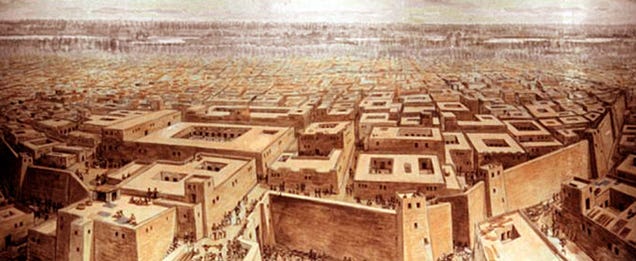 EXPAND
EXPAND
The Harappan civilization dominated the Indus River valley beginning about five thousand years ago, many of its massive cities sprawling at the edges of rivers that still flow through Pakistan and India today. But its culture remains a mystery. Why did it leave behind no representations of great leaders, nor of warfare?
Archaeologists have long wondered whether the Harappan civilization could actually have thrived for roughly 2,000 years without any major wars or leadership cults. Obviously people had conflicts, sometimes with deadly results — graves reveal ample skull injuries caused by blows to the head. But there is no evidence that any Harappan city was ever burned, besieged by an army, or taken over by force from within. Sifting through the archaeological layers of these cities, scientists find no layers of ash that would suggest the city had been burned down, and no signs of mass destruction. There are no enormous caches of weapons, and not even any art representing warfare.
That would make the Harappan civilization an historical outlier in any era. But it's especially noteworthy at a time when neighboring civilizations in Mesopotamia were erecting massive war monuments, and using cuneiform writing on clay tablets to chronicle how their leaders slaughtered and enslaved thousands.
What exactly were the Harappans doing instead of focusing their energies on military conquest?
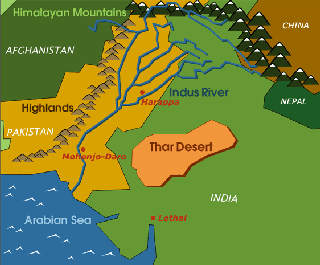 EXPAND
EXPANDThe Harappan People
The Indus River flows out of the Himalayas, bringing fresh water to the warm, dry valley where the ancient city of Harappa first began to grow. The Harappan civilization is the namesake of this city, located between two rivers, whose arts, written language, and science spread to several other large, riverside cities in the area. Mohenjo-Daro was the largest of these cities with a population of roughly 80,000 people. Archaeologists have recently analyzed the teeth of people buried in Mohenjo-Daro's graveyards, searching for telltale chemical traces that reveal where these people drank water as children. They discovered that many had grown up drinking water from elsewhere in the region, meaningthat a lot of the city's inhabitants were migrants who had come to the city as adults.
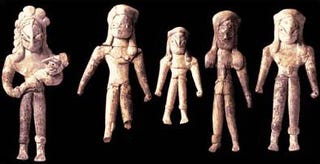 EXPAND
EXPAND
Art from Harappan cities also attests to a very mixed population, with statues showing people who sport a wide variety of clothing and hair styles. So the Harappans appear to have been a very diverse lot. Some traveled far from their cities, probably by boat across the Persian Gulf, to trade with other great civilizations in the region during the 2000s BCE. There was at least one Harappan trade outpost in Mesopotamia, in the city of Eshnunna, which today lies about 30 km northeast of Baghdad. People from other Mesopotamian cities like Ur owned distinctively Harappan luxury goods such as beads and tiny carved bones.
Harappans appear to have been traders who welcomed people to their cities from pretty much anywhere. But that doesn't mean they were disorganized or anarchic.
Standard Measures and Writing
 EXPAND
EXPAND
By studying the layers of built environments in Harappa, archaeologists have pieced together a fragmentary history of the civilization's rise. Harappa began as a village, probably about 6,000 years ago. There's evidence of agriculture and very early pottery throughout the 3000s BCE.
It's also during this time that we begin to see markings that look like writing on pottery. Over a period of just a couple of centuries, these crude marks evolved quickly into an alphabet that we still can't decipher. Here you can see a typical example of Harappan writing, on a seal that would have been pressed into soft clay, and was probably used in trade.
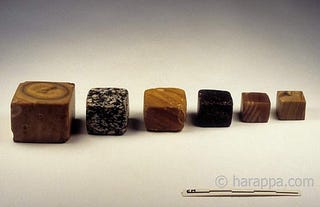 EXPAND
EXPAND
Indeed, it seems that writing in Harappa followed soon after the invention of standard weights and measures for commerce. Archaeologists have unearthed hundreds of blocks in a variety of standard sizes that conform to the binary weight system favored in the Indus Valley.
This fits with most accounts of how writing emerges in civilizations. Often, it begins with people using numbers and math to determine who owns what, or who has bought what from whom. From there, it develops quickly into a full-blown system of symbols. Writing seems to be one of those technological innovations that evolves very rapidly once people start using it.
It's next to impossible to build an urban civilization without standard measures and writing, but it's rare that we have a chance to look back in history to glimpse a literate culture emerging from a pre-literate one. In the ruins of Harappa, we can track that transition taking place. And the more writing we see in a given layer, the more complicated and advanced the civilization had become.
Advanced Technologies and Civil Engineering
Harappans didn't just create standardized measures — they liked everything to be standardized, right down to the size of the bricks they used to build their homes. Bricks and boards, like weights, came in just a few standard sizes. Echoing this love of order, Harappans built their cities on fairly strict grids.
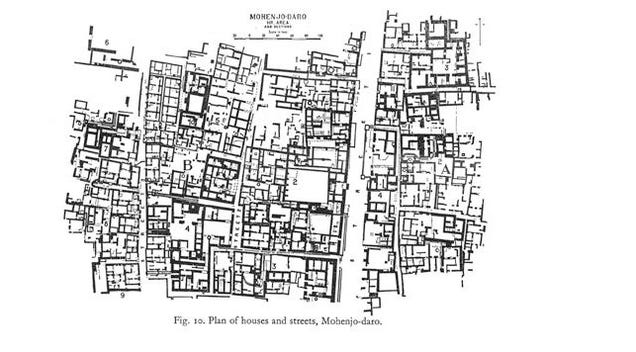 EXPAND
EXPAND
Above is a sketch of the city plan of Mohenjo-Daro, based on what we've been able to reconstruct from ruins. There are several wide promenades — large enough for two carts to drive side-by-side — that passed through the city, then out of the gates and into the farmlands beyond.
Though the idea of a street grid seems perfectly ordinary to city-dwellers today, it was unusual at the time. Most great cities in Mesopotamia, for example, had curving streets and a more organic-looking layout (you can see a nice reconstruction of Ur's city plan here [PDF]).
Sometimes archaeologists call the Harappan architectural style "nested" because they loved to build walls within walls. Every city was surrounded by a wall, but once inside, residents would find themselves walking past several more walled enclosures. We're not entirely sure why the Harappans designed their cities this way, but it's possible that these inner walls protected sacred areas or the estates of particularly high-status citizens.
I mentioned earlier that the Harappans left no monuments to their leaders, but their walls and city layouts make it clear that they were hardly egalitarians. Homes ranged from single rooms in dormitory-like buildings, possibly for slaves, to palatial estates with dozens of rooms and multiple outdoor courtyards. Harappans preferred two-story buildings, and semi-public courtyards were part of nearly every home.
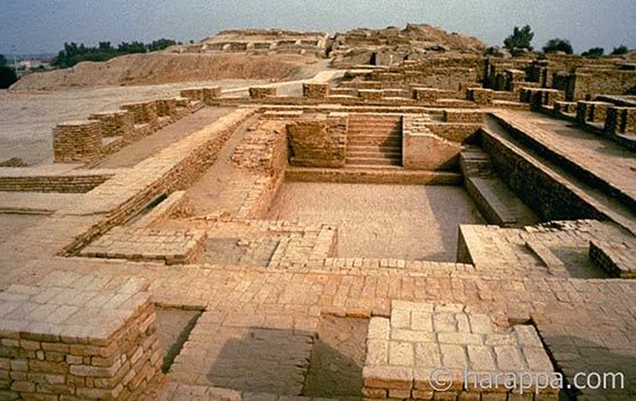 EXPAND
EXPAND
There were regions of Harappan cities, often in their northwest corners, that were elevated above the rest. One of these elevated areas — surrounded by walls, of course — has been excavated extensively at Mohenjo-Daro. Dubbed (somewhat incorrectly) "the citadel," it includes what some archaeologists believe is a granary, as well as large, public buildings whose uses remain mysterious. But one structure stands out, partly because its design is tied to one of the greatest technological innovations of the Harappan city.
It's a public bath.
You can see it above, along with the grand staircase that would have taken visitors down into its waters. The floor of the bath was built from specially-sized fired bricks, and it was surrounded by many passages and small rooms. Whether or not this particular bath was simply a public bathing site, or perhaps something more ceremonial, it was the largest version of a technology that was common throughout Harappan cities.
Because, you see, Harappans had plumbing. Every home had bathrooms, many had toilets, and drainage ditches throughout their cities carried waste beyond its walls. In fact, one way we know that the Harappans set up outposts in Mesopotamia is that their cities had such sophisticated, distinctive plumbing. Perhaps, instead of making war, the Harappans were devoting their money and energy to city infrastructure planning. Below, you can see an artist's recreation of what a city's plumbing would look like. Clay pipes ran alongside city streets, and past homes.
 1EXPAND
1EXPAND
Harappans were also spending a lot of time perfecting the art of luxury goods. They made bangles, carved decorative bones, worked copper and other metals. Most of all, they crafted beads that must have been famous for thousands of kilometers, given that archaeologists have found them in far-flung Mesopotamian cities.
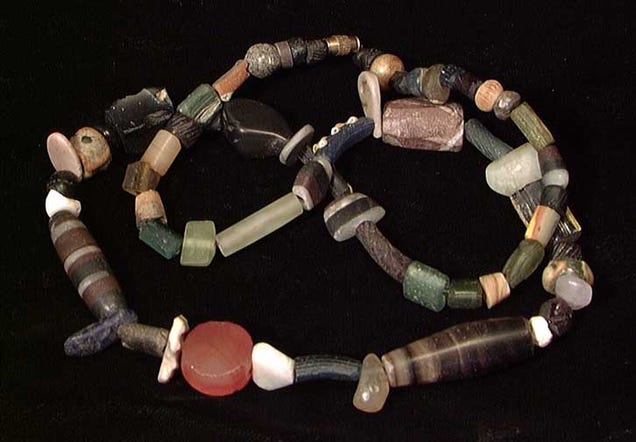 EXPAND
EXPAND
Above are some examples of the kinds of beads made in the Indus Valley. They were carved from stones, crystals and gems — and they were polished to a fine luster. Every Harappan city that we've excavated has an area that's packed with shops where artisans and engineers crafted goods for trade. We've even found scraps of cotton, which suggests that the Harappans may have been very early cultivators of this crop that later became the foundation of many textile industries in the region.
Women and Men
What little we know of Harappan social life comes from statues and graves. This figurine captures a woman in mid-stride, wearing the bangles so popular in Harappan shops. Her hair is styled in an elaborate twist, and the expression on her face hovers between amused and defiant. Some have called her a "dancer," but she might just as easily be standing with arms akimbo.
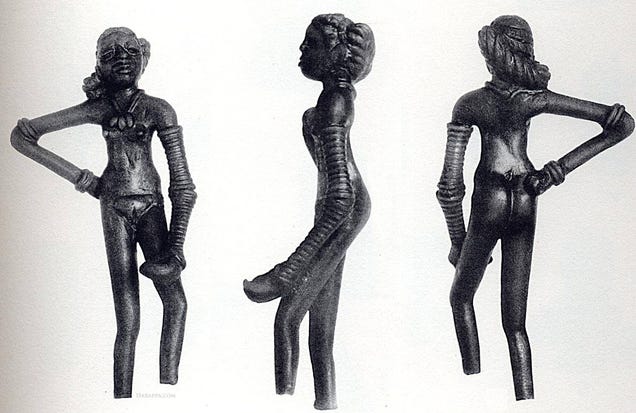 2EXPAND
2EXPAND
The archaeologists who studied the teeth of people in Harappan graves noticed an interesting pattern when it came to couples who had been buried side-by-side. Because teeth gave them clues about where people were from, they knew which skeletons were from native Harappan city-dwellers. And in many instances, they found Harappan women buried with migrant men.
Could this mean that Harappan people participated in a tradition where husbands came to live with the families of their wives? In nearby Mesopotamia, this practice was unknown — women became the property of their husbands, and thus went to live with their new owners.
Perhaps the Indus Valley style of marriage was one way that Harappan cities were able to attract so many immigrants. Or perhaps it was a sign that women in a city like Mohenjo-Daro wouldn't have been relegated to the status of property.
We simply can't ever know. Some scientists have suggested that women must have been respected as people among Harappans, because so many of the surviving statues from the Indus Valley cultures are of women. But that could be a red herring — after all, Catholic cultures in the middle ages were extremely patriarchal, though they produced some of the most beautiful and enduring portraits of the Virgin Mary. Representing women in art is not the same thing as representing them in city government.
All we really know is that Harappan women often married men who came from beyond the walls of their cities. And some of them probably liked to dance.
The End of Indus Valley Cities
Unlike other ancient civilizations in Egypt and China, the Harappan civilization has no obvious inheritors. When people began leaving Harappan cities in the late 1000s BCE, there is no obvious route that they took. Archaeologists studying the decline of this ancient civilization point to several factors that led to its death.
First, there was a rather brutal climate change that began in the early 1000s BCE. Monsoons came irregularly, and the once-fertile valley became parched. Add to this drought the fact that the cities had already been over-farming, and it's likely that starvation began driving people away from Harappa. There is also ample evidence that people in the cities were suffering from tuberculosis and other infectious diseases. The one-two punch of famine and plague left the region depopulated.
The last Harappan city to be abandoned was its largest, Mohenjo-Daro. During the final centuries of its occupation, the city infrastructure began to fall apart and we see fewer examples of writing. There is also some evidence of warfare — probably on the scale of gang violence. One grave outside the city walls is full of bodies where the skulls have been smashed open. In previous centuries, head injuries from fighting were sometimes survivable — doctors often treated them with trepanation, or skull-drilling. But in the waning days of the city, people with skull injuries were dumped into mass graves.
Until we decipher the Indus writing system, it's unlikely that we'll ever know precisely what brought the Harappan people together into such technologically advanced cities — nor what drove them out. But the remains of their civilization have beckoned the curious for over a century now. And with each new archaeological dig, we learn more. Perhaps, at some point, we'll even discover how the Harappans managed to escape the ravages of war for over 2,000 years.
Annalee Newitz is the editor-in-chief of io9. She's also the author of a book calledScatter, Adapt and Remember: How Humans Will Survive a Mass Extinction.


No comments:
Post a Comment